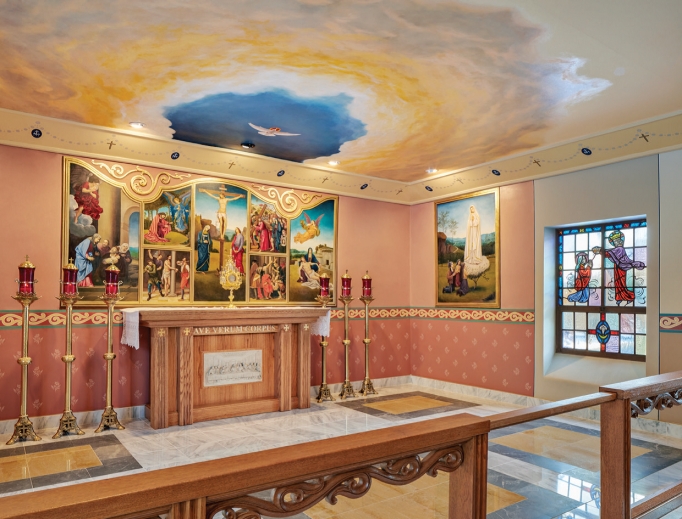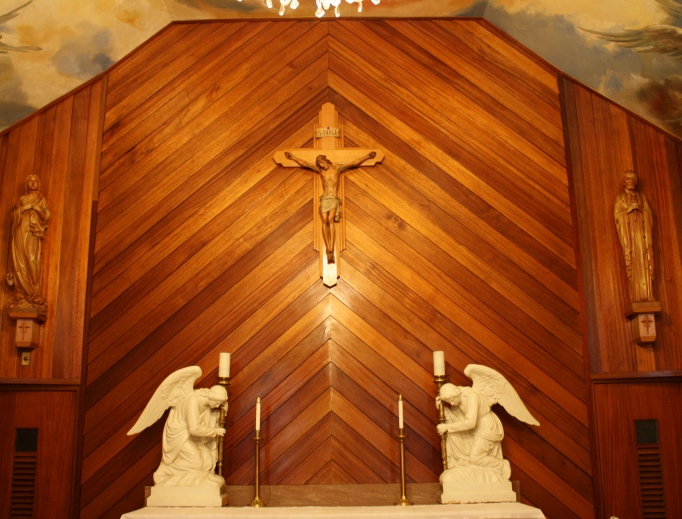Repurposing Sacred Spaces: Giving Holy Places New Life
TRAVEL feature

When Father Brian Gannon became pastor of St. Theresa Church in Trumbull, Connecticut, the parish’s former convent had been turned into office space and meeting rooms. The sisters’ chapel remained intact but was used only by some organizations for Benediction or short prayer time.
So Father Gannon decided to transform and repurpose the holy space for the spiritual growth of the 3,100-family parish. In October, the Diocese of Bridgeport’s Bishop Frank Caggiano dedicated the entirely remodeled sacred space as Our Lady of Fatima Perpetual Adoration Chapel.
This repurposing of the sacred space wasn’t a simple facelift or name change. The pastor picked a first-class company to transform it from the ground up.
“We chose the John Canning Co., which is famous for exceptional artistic ability and quality,” Father Gannon said, adding, “The Bible asks us to give our first fruits to God. We want to give the very best we can to beautify the holy and sacred place for the holist presence in the world, Our Lord in the most Holy Eucharist.”
The new adoration chapel radiates beauty, draws the faithful’s attention to the Eucharist, and at the same time reminds them of Fatima and its messages.
Fatima Focus
The original pews for 40 were retained and refinished, and fine-looking stained-glass windows of the Joyful Mysteries of the Rosary and Coronation of Mary, more than 55 years old, remain. Everything else became a work of beautiful liturgical art with Eucharistic and Marian images and symbols.
The newly crafted adoration altar of honey-stained oak features the phrase Ave Verum Corpus — “Behold the True Body” — in gold leaf. It also incorporates a white faux marble relief of the Last Supper, in keeping with historic elements.
Behind the altar, an expansive triptych painted mural-style and framed in gold acts as a reredos. Its seven separate paintings reflect Old Masters’ works, beginning with the Crucifixion in the center behind the monstrance and surrounded by the other Sorrowful Mysteries. One triptych wing presents the Presentation, with the opposite one showcasing the Pietà, giving pray-ers plenty to ponder.

With the chapel dedicated to Our Lady of Fatima, Canning’s David Ricco designed the space to reflect its name and “have liturgical significance and impact,” he said.
Ricco chose a soft rose color for the sanctuary walls, and under the murals rows of decorative roses reflect Our Lady.
The side walls in the sanctuary highlight Fatima. On one side, a mural illustrates an early apparition, showing the three young shepherd children kneeling before Our Lady, who stands on a cloud.
The mural on the opposite side of the chapel portrays Servant of God Lucia dos Santos’ major vision in the convent in Tuy, Spain, in 1929 — a revelation of the Immaculate Heart of Mary and of the Holy Trinity, a reference to the Holy Eucharist and the words “Grace and Mercy.”
As Father Gannon explained: “There’s a deep connection between Our Lady of Fatima and the Holy Eucharist because of the children’s reception of the Eucharist from the Angel at Fatima and also Sister Lucia’s vision of the Holy Trinity and in the front of Christ the Eucharist and his precious Blood pouring into the chalice.”
Marian symbols remind the faithful of Our Lady’s place in bringing us the Body of Christ now given us in the Eucharist and also the messages of Our Lady at Fatima. Around the walls, a continuous rosary encircles the chapel, with each draped decade of beads leading to a cross or Marian symbol. The walls also hold moving wood-carved Stations of the Cross.
Father Gannon finds people’s reactions overwhelmingly positive with the repurpose. “Hundreds of lives are now being slowly transformed by God’s supernatural ‘power grid’ in that chapel. Many people have told me how it’s been such a great source of nourishment, of healing and of peace.”
From Baptist to Catholic
The parish of Mater Misericordiae Catholic Church faced a different situation in the Diocese of Phoenix, Arizona.
In 2005 Bishop Thomas Olmstead invited the Priestly Fraternity of St. Peter (FSSP) to care for Catholics desiring the traditional Roman liturgy. The community shared a church with another parish, but due to growth with lots of young families, it needed an edifice of its own.
Father Joseph Terra of the FSSP, pastor at the time, found and bought an ideal property in Phoenix — a former Baptist church built in the 1950s that seats 220 parishioners.
It was well-constructed “at a time when they built churches to look like a church,” Father Terra said. But the very plain interior needed complete repurposing. The new parish had to do everything “basically from scratch, with the exception of the building.”
The pastor chose designer Anja Zunkeler of Zinclair Studios in California, who he calls “a wonderful artist, very versatile,” and simply told her, “Design it.” He believed the advantage to have her do the church by herself is that it becomes “the product of one hand, a beautifully united design.”
His input related to one particular item: a hand-carved wooden altar he found dismantled in a barn in Michigan and needing much restoration. He got it with Communion rails.
“I saw potential in it,” he said, “and one of the parishioners happened to be really good at faux marble.” Today, the altar looks as if it is crafted from stone.
In August 2010 once parishioners got to see the progress of the work, the project “did its own advertising,” Father Terra said. “I didn’t have to ask for any money. They took care of it.”
Zunkeler gave the church an Old World classical design. The beautiful sanctuary has Roman arches setting off the main altar with shrines to our Blessed Mother and St. Joseph on both sides. The faux marble reredos has a central, large crucifix above the tabernacle.
Intricate designs form the painted bands along walls, arches and ceiling. They radiate liturgical and Marian symbols, especially variations of the fleur-de-lis. The stained-glass windows designed by Zunkeler and fabricated by Richard Graf include six skylight windows in the sanctuary.
Four illustrate Sts. Michael, Gabriel and Raphael and the Angel of Fatima, and the others portray Sts. Maria Goretti and Dorothy, whose relics are placed in the altar.
All the upgrades were done without breaking the bank, the priest said.
“It is cheaper to get an existing church than to build from the ground up,” explained Father Terra, who is now chaplain to the Carmelite nuns in Post Falls, Idaho, and serves at St. Joan of Arc Catholic Church in Coeur d’Alene, Idaho. “Providence was watching out for us. God willed it. We were praying for that.” Yet cost was not foremost in his mind, as he didn’t want to shortchange beauty.
“God has certain qualities essential to his nature,” he explained. “John tells us God is love. God is truth, justice. The one thing you will see in heaven is the beauty of God. God is beauty. Therefore our churches must reflect to the best of our ability the beauty of God. An ugly church is a contradiction; it doesn’t believe in God. So a beautiful church is something that people need to be reminded of the beauty of God. And what better way of doing that than a beautiful church in which you celebrate beautiful liturgy.”
Chapel to Chapel Plus
In the Archdiocese of Hartford, Connecticut, Father James Sullivan also opted for a repurposing solution at Assumption Church in Ansonia. Because of the size of the handsome stone Gothic church built by Irish immigrants in the 1890s, weekday Masses had already been switched to the old 1950s former convent chapel. Nor was it advisable to keep the huge church open all day. So what was the solution?
The dated chapel with a tiled ceiling, orange chairs and old commercial carpet could only be entered from inside the building, which had become the parish offices and rectory. When Father Sullivan arrived as pastor two years ago and saw it, he said, “The first thing that came into my mind was — I can’t wait to restore it.”
With his former experience before ordination as co-owner of Sullivan Brothers, a building and remodeling and custom woodworking company that had done church remodeling and built a new chapel at Holy Apostles Seminary in Cromwell, Connecticut, he saw the solution. He was able to do hands-on work for repurposing the old chapel into a new one that became, so to speak, an auxiliary church. Men of the parish helped.

Father Sullivan opened up an exterior brick wall to place new arched double wooden doors for the chapel’s main entrance directly from the street. Now, people can come all day long until late evening to pray without having to enter through the offices/rectory.
Father Sullivan obtained an 1890s stained-glass window — the same age as the church — by the famed Munich glass studios for above the doors. It depicts an image of Christ: a pelican feeding the young with its own blood. The carpet gave way to tile, and the entire tri-part ceiling radiates with a glorious mural of celestial Marian scenes. For the murals, the pastor chose Manhattan artist Paul Armesto, who has done murals in several churches using techniques of the Old Masters. Armesto said he’s “trying to bring back the spirit of religious art that there was in the 16th and 17th centuries — the Renaissance period.”
“Art is an expression of love for God. In a chapel, which is a sacred place, you must give the best,” Armesto said. At the same time, “Art should uplift the spirit of the people.”
With the chapel dedicated this Feb. 9 by Archbishop Leonard Blair, worshippers now find themselves praying under a symmetrical celestial canopy with resplendent mirror-like Marian scenes on both sides. One image is of the Assumption, with the other of the Coronation, in which three angelic babies hold on to Mary’s flowing blue garment.
Father Sullivan said the babies being drawn to Christ can remind worshippers of those little ones who died in stillbirth, miscarriage and abortion. He will have a “Book of Life” for parents to write down the names of the children they may never have known on earth but who they will see in heaven.
Symbols abound, including eight angels on both sides, because eight is the biblical number of “superabundance.” One angel image holds a Celtic harp in a nod to the parish’s Irish origins. The portrayed angels also hold “sections” of the Hail Mary, the Magnificat and Hail, Holy Queen prayers.
Also present: 12 roses, and a Mary image holds a red rose to denote her as the Sorrowful Mother.
The new chapel, a well-decorated “little” church, holds 44 people and provides “a more intimate setting,” Father Sullivan said. It will accommodate small weddings and funerals amid liturgical beauty.
Each repurposed sacred space is accomplishing similar goals. As Father Gannon put it, “My ultimate hope is that more people and more of our families come to know the incredible love of God for them, his deepest desire to have them know the happiness that only comes from a deeper relationship with him through the Holy Eucharist. From there, the family will only grow stronger, with supernatural infusion of God’s love, and bring about greater works of love, of peace, of forgiveness and of healing for so many people in our very fallen world today.”
Register staff writer.
INFORMATION
StTheresaTrumbull.org
PhoenixLatinMass.org (Mater Misericordia)
AssumptionAnsonia.church
- Keywords:
- chapels
- church architecture
- joseph pronechen
















